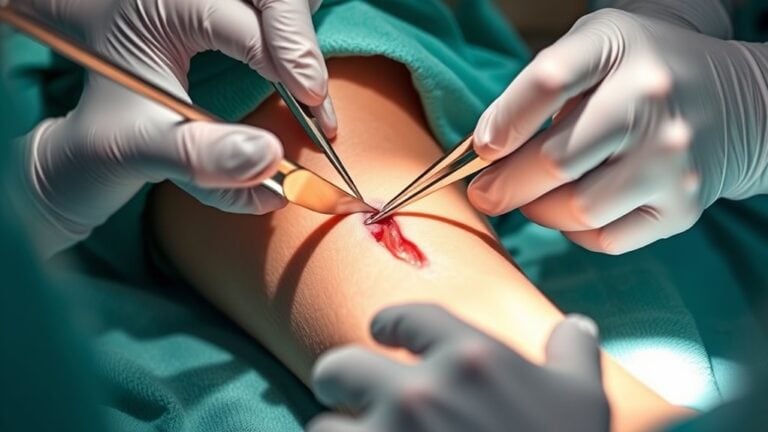A bile duct obstruction blocks the flow of bile, causing discomfort and potential complications. Symptoms like jaundice, dark urine, and abdominal pain often signal a problem, but pinpointing the exact cause requires careful evaluation. Doctors rely on blood tests, imaging scans, and specialized procedures to identify blockages from gallstones, tumors, or scarring. Treatment varies—some cases resolve with medication, while others need minimally invasive techniques or surgery. Comprehension of the options can ease uncertainty about next steps.
What Is a Bile Duct Obstruction?
The bile ducts are narrow highways transporting bile—a bitter, yellowish-green fluid—from the liver to the gallbladder and small intestine. A bile duct obstruction occurs when something blocks these ducts, disrupting the flow of bile needed for digestion.
This biliary blockage can stem from gallstones, tumors, inflammation, or scarring. When bile can’t pass through, it backs up into the liver, potentially causing serious complications.
The liver, gallbladder, and ducts work together to process fats, so a blockage affects digestion and overall health. Prompt diagnosis is crucial to prevent damage, often involving imaging tests or blood work.
Comprehending the cause of the obstruction helps guide treatment, whether it’s removing gallstones or addressing other issues. Left untreated, blockages can lead to infections or liver problems.
Common Symptoms of a Bile Duct Obstruction
Because bile plays a key role in digestion, a blockage in the bile ducts often triggers noticeable symptoms that shouldn’t be disregarded. A bile duct obstruction disrupts the flow of bile, leading to a range of uncomfortable and sometimes alarming signs.
- Jaundice: Yellowing of the skin and eyes due to bilirubin buildup.
- Abdominal pain: A dull or sharp ache in the upper right or middle abdomen.
- Dark urine and pale stools: Urine may appear tea-colored, while stools lose their normal brown hue.
- Fever, chills, and pruritus: Itchy skin or flu-like symptoms may signal infection or inflammation.
Nausea, unexplained weight loss, and fatigue can also occur. Recognizing these symptoms promptly assists in seeking timely medical care, preventing complications. If these signs persist, consulting a healthcare provider is pivotal.
Causes and Risk Factors for Bile Duct Obstruction
Bile duct obstruction often occurs due to gallstones, which can block the flow of bile and cause significant discomfort. Tumors or strictures—narrowing of the bile ducts—may also obstruct bile flow, whether from cancerous growths or scarring.
Infections or chronic inflammation, such as pancreatitis, further contribute to the risk of bile duct blockage.
Gallstones and Blockages
As gallstones slip into the bile ducts, they can create painful blockages, making them the leading cause of bile duct obstructions. These hardened deposits disrupt bile flow from the liver, leading to a blocked bile duct and potential complications.
The biliary system relies on clear pathways, but when gallstones block bile, symptoms like jaundice or severe abdominal pain may arise.
- Gallbladder removal increases the risk of stones migrating into the bile ducts.
- A bile duct becomes blocked when stones lodge tightly, halting digestion.
- Biliary obstruction triggers inflammation, often requiring urgent care.
- Chronic issues like bile duct obstruction can damage the liver over time.
Risk factors include obesity, rapid weight loss, or high-fat diets. Prompt detection helps prevent severe damage to the biliary system.
Tumors and Strictures
Tumors and strictures sometimes play a major role in blocking bile ducts, creating problems that go beyond gallstones. Both benign and malignant tumors can press on or invade the bile ducts, leading to obstruction. Pancreatic cancer, for example, often grows near the bile ducts, causing blockages.
Strictures—narrowing of the ducts—can form due to chronic inflammation, scarring from conditions like chronic pancreatitis, or injury during procedures like cholecystectomy. These strictures restrict bile flow, leading to complications.
While tumors may require imaging or biopsies for diagnosis, strictures often stem from long-term damage. Early detection is crucial, as untreated obstructions can worsen symptoms like jaundice or infections. Understanding these causes helps guide treatment decisions and improve outcomes.
Infections and Inflammation
Many people don’t realize how easily infections or inflammation can trigger bile duct blockages, making it harder for the body to process waste. When the bile duct becomes inflamed or infected, swelling narrows the passage, leading to obstruction.
Infections: Bacterial or parasitic infections can inflame the bile duct, especially in those with weakened immune systems.
Pancreatitis: Chronic inflammation of the pancreas presses on nearby bile ducts, restricting bile flow.
Caroli Disease: This rare condition causes bile duct cysts, trapping bile and increasing infection risks.
Trauma: Abdominal injuries or surgeries might scar or damage the ducts, causing inflammation and blockages.
Autoimmune conditions, like autoimmune pancreatitis, also attack bile ducts, creating strictures. Recognizing these triggers helps manage symptoms promptly and prevent complications.
Diagnostic Tests for Bile Duct Obstruction
Diagnosing bile duct obstruction involves a combination of tests to pinpoint the cause and severity of the blockage. Blood tests check for elevated liver enzymes and bilirubin, which signal liver stress or bile buildup.
An abdominal ultrasound is often the initial imaging test, revealing structural issues like gallstones or duct enlargement. For more detail, CT scans or MRI with MRCP provide clearer visuals of the bile ducts and surrounding organs.
If a blockage is suspected, ERCP or PTC may be utilized—these procedures allow doctors to see and sometimes treat the obstruction directly. A HIDA scan tracks bile flow, helping identify where the blockage occurs.
Each test plays a role in creating a comprehensive view of the problem, guiding the next steps in care.
Treatment Options for Bile Duct Obstruction
Several approaches exist to relieve bile duct obstruction, depending on its cause and severity.
- Endoscopic retrograde cholangiopancreatography (ERCP): A flexible tube with a camera is passed through the mouth to remove stones or place a stent to open blocked ducts.
- Percutaneous transhepatic cholangiography (PTC): A needle is inserted through the skin into the liver to drain bile or place a stent when ERCP isn’t viable.
- Surgical options: Choledocholithotomy removes large stones, while hepaticojejunostomy reroutes bile flow in cases of bile duct cancer or chronic pancreatitis.
- Medications: Ursodeoxycholic acid can dissolve small gallstones, avoiding invasive procedures. Severe cases may necessitate surgical bypass or liver transplantation.
Each method aims to restore bile flow and prevent complications.
Prevention and Long-Term Management Strategies
Preventing bile duct obstructions starts with comprehending the risks and taking steps to protect liver and gallbladder health. Reducing dietary cholesterol and maintaining a healthy weight can lower the risk of gallstones, a leading cause of blockages.
Limiting alcohol consumption helps prevent liver disease and cirrhosis, which may contribute to bile duct issues. Prompt detection through early diagnosis improves outcomes, especially when infections or liver inflammation are involved. Managing underlying causes, such as cancer, is critical for long-term prognosis.
Regular check-ups and monitoring liver function can catch problems before they worsen. Staying hydrated and eating fiber-rich foods support digestion, reducing strain on the bile ducts. Avoiding rapid weight loss also minimizes gallstone formation. These proactive steps help maintain bile duct health and prevent complications.




